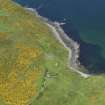Gardenstown, St John's Church
Burial Ground (Medieval), Church (Medieval), Grave Marker (16th Century), Grave Slab(S) (17th Century) - (19th Century)
Site Name Gardenstown, St John's Church
Classification Burial Ground (Medieval), Church (Medieval), Grave Marker (16th Century), Grave Slab(S) (17th Century) - (19th Century)
Canmore ID 19282
Site Number NJ76SE 2
NGR NJ 79109 64464
Datum OSGB36 - NGR
Permalink http://canmore.org.uk/site/19282
- Council Aberdeenshire
- Parish Gamrie
- Former Region Grampian
- Former District Banff And Buchan
- Former County Banffshire
NJ76SE 2 79109 64464
(NJ 7911 6445) St John's Church (NR) (In Ruins)
OS 6" map, Banffshire, 2nd ed., (1904)
For successor and present church (NJ 7930 6270), see NJ76SE 18.
These are the ruins of the former parish church, dedicated to St John the Evangelist,and traditionally said to have been founded in AD 1004. It is frequently referred to in the 12th and following centuries. It was formerly known as the 'Kirk of Sculls' from the 3 skulls, said to be of Danes, which decorated the inside of the church.
The church is rectangular in plan, 94'4" by 15'6". It has been built in two periods - the east end being probably early 16th century and the rest 17th century. Only the walls remain.
Another parish church was built in 1830 when, presumably, the old church was allowed to fall into ruin.
OSA 1791-9; NSA 1845; D MacGibbon and T Ross 1896-7.
St John's Church is as described above. The walls and gables remain to roof height, and were re-pointed in 1961.
Visited by OS (RL) 25 January 1968.
Project (28 June 2017 - 29 June 2017)
NJ 79109 64464 A geophysical survey was undertaken, 28–29 June 2017, within the church and graveyard. Although the extant church is late medieval in date, there is a possibility that an earlier 11th-century church existed and there is also documentary evidence for a 12th-century church.
Resistance survey was carried out in the church and the wider graveyard. Ground Penetrating Radar (GPR) survey was carried out within and immediately surrounding the church.
While neither the resistance nor the GPR surveys identified clearly defined anomalies, several discrete responses were identified in the church. However, the significance of these is unclear. Some may be due to burials, while others could be due to rubble beneath the surface.
A few rectilinear responses suggesting possible structural remains were noted, although interpretation is extremely cautious given the suspected large number of burials. However, some of the anomalies show correlation with early OS maps of the site.
Archive: Rose Geophysical Consultants
Funder: Murray Archaeological Services/Aberdeenshire Council
Susan Ovenden – Rose Geophysical Consultants
(Source: DES, Volume 18)
Ground Penetrating Radar (28 June 2017 - 29 June 2017)
NJ 79109 64464 Ground penetrating survey.
Archive: Rose Geophysical Consultants
Funder: Murray Archaeological Services/Aberdeenshire Council
Susan Ovenden – Rose Geophysical Consultants
(Source: DES, Volume 18)
Earth Resistance Survey (28 June 2017 - 29 June 2017)
NJ 79109 64464 Resistance survey.
Archive: Rose Geophysical Consultants
Funder: Murray Archaeological Services/Aberdeenshire Council
Susan Ovenden – Rose Geophysical Consultants
(Source: DES, Volume 18)
Standing Building Recording (22 May 2017 - 4 July 2017)
NJ 79100 64460 (NJ76SE 0002) St John’s is a small medieval parish church that continued in use after the Reformation until it was replaced in the 19th century. A programme of detailed recording was undertaken, 22 May – 4 July 2017, to record structural differences that reflect the changes of religious practice. Local tradition dates a church on this site to 1004. However, there is no reliable documentary evidence of its existence until the late 12th century.
The E end of the church, which is c8–10m long, has generally been regarded as the earliest part. It would have been the chancel of the pre-Reformation church, and a number of features can be identified. There is an aumbry in the E wall. A recess in the E end of the N wall has been
tentatively identified as a piscina, a hypothesis which may be tested when the concrete render is removed. A recess beside a door in the S wall may have held a holy water stoup. Later, the building was extended to a length of 29m externally; this longer rectangular plan is comparable to other churches in the region which had been extended in the late medieval or
post-medieval period. After the Reformation, it is probable that new doorways were made in the E and W gables and a belfry added to the W gable.
Archive: Aberdeenshire SMR
Funder: Aberdeenshire Council
Hilary and Charlie Murray - Murray Archaeological Services Ltd
(Source: DES, Volume 18)
Field Visit (May 2022)
NJ 79109 64464 Visited during fieldwork by SCAPE. Remains of the former parish church dedicated to St John the Evangelist said to be founded in the 11th century. The present church has been built in two periods at least, the east end probably early 16th century and the rest 17th century. It measures 28.75m long (longer than most churches of the time) by 4.72m wide and rubble built. The wall and gable remain to roof height.
Church fabric is suffering from structural instability. Low tech but effective interventions have been installed. Wooden props support lintels of windows. Sand bags fill and support a hole in the north wall. The northeast stretch of church yard wall is built at the edge of the break of slope at the top of the cliff. There are obvious signs of long term slope processes as sections of the cliff periodically slip. These are natural processes but the wall will eventually fail.
Information from S. Boyd and J. Hambly - Scottish Coastal Archaeology and the Problem of Erosion (SCAPE)
























































































































































































